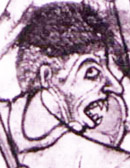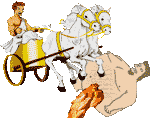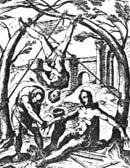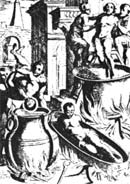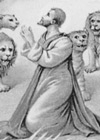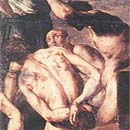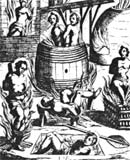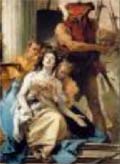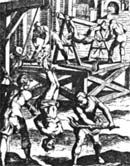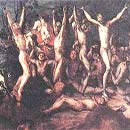The fact is that for seven of the twelve, our only early source, the Gospels, say nothing about them at all. They are just names on a list.
Isn’t it a tad odd that such worthies, infused with the Holy Spirit and given powers to heal the sick and cast out demons, wrote nothing, or had nothing written for them or about them? Isn’t it odd that men chosen to be eye-witnesses to the mighty deeds of Jesus, wrote no eye-witness statements, left no sermons, no memoirs, no letters, no teachings, no pithy words of encouragement?
All that we have about “the twelve” are conflicting legends and fantastic stories from a much later date, tall stories about where they went, what they did and most especially how they died. Their deaths, it seems, have been recorded in loving and lurid detail. And it is the graphic deaths of the disciples that solves the riddle. We’ve all heard the apologetic claim: “Would they have died for a lie? Therefore the story of Jesus must be true.”
But we all know how useful to a cause is a dead martyr, even if he’s a fiction. In the case of Jesus, the twelve are a fiction, a necessary entourage for a sun god, passing through the twelve constellations of the zodiac. Just like other saviour gods, Jesus had to have his retinue.
The truth is, the twelve disciples are a grubby and sordid invention.
“Would the disciples have suffered and died for a fabricated saviour?”
ne of the reeds of straw holding up the shabby edifice of Christendom is the alleged suffering and cruel fate of his original apostles, the twelve disciples chosen by the Lord himself. By their heroic, cheek-turning sacrifice, these worthies earned their martyr’s crown and joined their Lord in Heaven. In so-doing, they inspired generations of noble Christians, who ultimately taught the blood-thirsty Romans the Christian values of compassion and brotherly love. Well, that’s the myth.
“The LORD spoke to Joshua, saying: ‘Take for yourselves twelve men from the people, one man from every tribe’ … Then Joshua called the twelve men whom he had appointed from the children of Israel, one man from every tribe.” – Joshua 4.1-4.
The parallels don’t end there. Matthew’s Jesus promises his groupies that they will “sit on twelve thrones, judging the twelve tribes of Israel.” – Matthew 19.28.
2nd century texts known as the “Clementines” had made Peter the “first Bishop of Rome” and 3rd century invention gave him a 25-year pontificate – which made it a tad tricky for him to have died at the hands of Nero but, hey, this is “tradition.”
3rd century Church Father Origen dreamed up a colourful flourish: Peter, feeling himself unworthy to be crucified the same way as his Lord, chose option ‘B’ – crucifixion upside down!
This guy has to be kept alive long enough to take care of Mary, lead the church in Ephesus, write the Book of Revelation and write his own gospel. He even survives being boiled in oil and is given a natural death!
Actually, John bar Zebedee disappears from the yarn in Acts at the same time his brother James is more dramatically removed from the story. The last reference to John is also verse 12.2. From Acts 12.12 onward we are dealing with another John “whose surname was Mark” – a lightweight character who nonetheless is credited with authorship of the first gospel
The impending demotion of the thunder brothers is actually prefigured in Mark’s gospel (and is embellished in Matthew, where Mrs Zebedee does the talking). The boys ask for front seats in the hereafter. JC is having none of it:
“And James and John, the sons of Zebedee, come unto him, saying, Master, we would that thou shouldest do for us whatsoever we shall desire. And he said unto them, What would ye that I should do for you? They said unto him, Grant unto us that we may sit, one on thy right hand, and the other on thy left hand, in thy glory.
“Jesus said unto them … to sit on my right hand and on my left hand is not mine to give; but it shall be given to them for whom it is prepared. And when the ten heard it, they began to be much displeased with James and John.” – Mark 10:35-41.
Pious invention gives Andrew a wonderful career covering everywhere from Scythia to Greece, from Asia Minor to Thrace. This guy, it seems, took option ‘C’ on the crucifixion menu: on an x-shaped cross. Apparently this allowed him to continue preaching for 2 days.
Fable places this guy in Phrygia, Carthage and Asia Minor. The fairy tale has a proconsul crucifying him for converting his wife. Perhaps the love feast got a bit out of hand.
Somewhat confusingly, there are actually two Philips. The original apostle disappears from the tale after witnessing Jesus rise to Heaven from the Mount of Olives. Philip and the rest of the gang return to the upper room in Acts 1.13. But in Acts 6.5 a second Philip is chosen as one of the seven given responsibility for feeding widows
What a traveller – India, Persia, Armenia, Ethiopia and southern Arabia! Miraculously he managed to get himself crucified (flayed alive and beheaded!) in both India and Armenia. Pretty impressive stuff. Even when dead his bits got about: a church in Rome claimed most of his corpse but 11th century Canterbury did a roaring trade with his arm! His emblem is the flaying knife. Cool.
Another grand traveller, seen everywhere from Parthia to Kerala in south India. 4th century invention, appropriately enough, gives this ‘twin’ two martyrdoms, one in Persia and one in India. He even gets a burial in Syria to boot! Yet another resting place, Mylapore, was claimed by the Portuguese in 16th century. Most famous for his “doubt”, Thomas inspired a whole raft of pious flimflam: the Acts of Thomas (he built a palace for an Indian king, would you believe), the Apocalypse of Thomas, the Gospel of Thomas, and the Infant Gospel of Thomas.
Now, have you still got any doubts …?
The myth-makers really go to town for this guy. Thrown down over 100 feet from the pinnacle of the Temple by “scribes and Pharisees”, he actually survived only to be stoned, have his brains dashed out with a fuller’s club and have his body “sawn asunder” – all this at the age of 90!
Of course, if we don’t conflate James the Less with James the brother of Jesus (an identification made by Jerome and later Catholics) all this mayhem belongs with the righteous James and the fate of the lesser James is unknown.
Perhaps it’s the being sawn in half which causes the confusion?
Either a serious clubbing or crucifixion for this mixed up guy in the city of Edessa or Persia. Apparently his fan-club suffered because his name sounded too much like Judas.
Jude the apostle is often conflated with Jude the brother of Jesus and also with Jude the writer of the epistle of Jude (pay attention, there will be a test). Yet Jude (the letter writer) identifies himself as the brother of James and as a servant of Jesus, not his brother (Jude 1.1). He also speaks of the apostles in the past tense, not as if he was one of them (verse 17), so he cannot be identified as one of “the twelve” either.
Invention came late for this guy. When it did, it was a beauty – crucifixion in Persia and also crucifixion thousands of miles away in Britain. He also managed to preach in Africa. Quite an act to follow.
Fantasy sends this guy to Syria, Cappadocia, the shores of the Caspian and the “City of Cannibals” (Acts of Andrew and Matthias). Death by burning. Also death in Jerusalem by stoning – and beheading. Really just makes up the numbers, sometimes merging with Matthew and sometimes swapped out to let Paul into “the twelve.”
Nothing yet. Feeling inspired?
Refer to his alter ego Matthew.
“Hanged on an olive tree.” Or, “lived to the age of 84 and died unmarried.” Body parts claimed by both Padua and Constantinople.
“Beheaded by Nero.” No, not really, but legend tells us he shared the same fate as Peter, even dying on the same day. Pious romances scribbled between the 2nd and 4th centuries – Acts of Paul, the Apocalypse of Paul, the Martyrdom of Paul and the Acts of Paul and Thecla – provide all the fabulous nonsense you could ever wish for.
